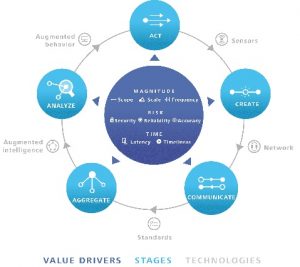Turnkey IoT: Balancing customizability and ease of implementation
Imagine walking into a store and being offered two choices: You can have a fine, handsomely tailored overcoat in four weeks for $1,000, or you can have a one-size-fits-all hoody today for $10. Your choice is between customization and ease of implementation. You can have the perfect solution for you, but it will take time to implement and be costly to get right. Or you can settle for an off-the-shelf solution that is quick and easy, but doesn’t really meet all of your needs, and may not be durable. That is exactly the choice facing many companies when deciding on new implementations of the internet of things. But it doesn’t have to be so. There is a better way.
The intersection of information and technology
IoT is a mix of several different types of technology: sensors, radios, communication protocols, analytics software and interactive displays. For a company attempting to implement IoT, sorting through all of the choices for all of these technologies, determining which components are the best mates, analyzing which suppliers are the most reliable, and providing for longer-term servicing issues can become quite daunting.
One way to cut through all the uncertainty is to find prepackaged, bundled IoT systems. Dozens of enterprises across sectors, such as online and offline retail, insurance and consumer products, have deployed bundled IoT technologies over the last 12–18 months. And the trend shows no signs of stopping. Venture capital investments in bundled IoT solutions providers increased 85% in 2015 versus the prior year, totaling $2.2 billion and accounting for 61% of total IoT venture funding.
Unfortunately, too often these bundles can be like a one-size-fits-all hoody — they may be low-cost, but they offer just one solution, which may or may not be precisely what your business needs. But when the alternative is a costly, time-intensive customized implementation, the choice can be difficult.
The core challenge of IoT is finding solutions that combine the variety of technologies IoT utilizes, solutions that work together in a secure way to achieve a specific, meaningful business results. Here’s an easy way to visualize this: the information value loop (see Figure 1). This loop not only shows how the component technologies of IoT must come together, but illustrates the goal of all those technologies working together — allowing information about the physical world to be analyzed digitally and the conclusions be used to help make the physical world better.
You want the information collected by IoT to be customized for your business need, but you want the technology to be as common as possible. Common technology generally allows for easy implementation, while the customized information typically ensures that the IoT solution serves your specific business need. In the tailored coat analogy, this solution is like ordering a jacket of a common style, but in your specific size. You get exactly what you need, and relatively easily to boot.
The key solution: Turnkey IoT
What I’m describing might be called “turnkey IoT.” Here’s how it works:
- Think big. An enterprise begins by assessing where in their operations they need greater information from the physical world. This information could be anything from the condition of important machinery, or the location of time sensitive shipments, or even the number of valuable replacement parts. The important part is that the information need is specific to the business.
- Start small. With a specific information need in mind, companies can quickly scope a small project that offers demonstrated ROI and tangible benefits. Engineers can then bring to bear standardized kits of technology featuring cloud-based platforms and common sensors to speed implementation. Typically, such turnkey proofs of concept can begin delivering value in weeks rather than months.
- Scale fast. Once a project is operating, that is not the end. If the solution seems like it’s working, companies should iterate on it, tweak it, enhance it and work with others to scale the project. Scaling does not just mean adding more sensors, but is really about acting on the insights IoT produces to do things differently — changing business processes, saving money, serving customers more effectively.
Following these simple steps, a turnkey IoT solution can deliver tangible value in the operations of both technology and people. Companies can reduce inventory by 3-5% and increase both the quality and efficiency of labor by 4-7% (based on Deloitte Consulting case studies). Perhaps more importantly, it can start delivering these real business benefits in a matter of weeks, not months. A customized solution with ease of implementation. Turnkey IoT can be that warm, perfectly fitting coat for your business.
Learn more about turnkey IoT solutions jointly developed by Deloitte and our alliance network.
As used in this document, “Deloitte” means Deloitte Consulting LLP, a subsidiary of Deloitte LLP. Please see www.deloitte.com/us/about for a detailed description of our legal structure. Certain services may not be available to attest clients under the rules and regulations of public accounting.
All IoT Agenda network contributors are responsible for the content and accuracy of their posts. Opinions are of the writers and do not necessarily convey the thoughts of IoT Agenda.

